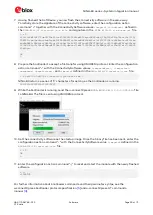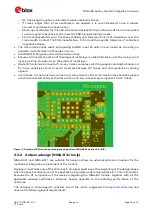
NINA-B3 series - System integration manual
UBX-17056748 - R13
Design-in
Page 35 of 72
C1-Public
•
External antennas, such as a linear monopole:
o
External antennas basically do not impose any physical restrictions on the design of the PCB
where the module is mounted.
o
The radiation performance mainly depends on the antennas. It is required to select antennas
with optimal radiating performance in the operating bands.
o
RF cables should be carefully selected with minimum insertion losses. Additional insertion loss
will be introduced by low quality or long cables. Large insertion loss reduces radiation
performance.
o
A high quality 50
coaxial connector provides proper PCB-to-RF-cable transition.
•
Integrated antennas such as patch-like antennas:
o
Internal integrated antennas impose physical restrictions on the PCB design:
An integrated antenna excites RF currents on its counterpoise, typically the PCB ground plane
of the device that becomes part of the antenna; its dimension defines the minimum frequency
that can be radiated. As the orientation of the ground plane related to the antenna element
must be considered, the ground plane can be reduced to a minimum size that is similar to the
quarter of the wavelength of the minimum frequency that needs to be radiated.
The RF isolation between antennas in the system must be as high as possible and the
correlation between the 3D radiation patterns of the two antennas must be as low as possible.
In general, an RF separation of at least a quarter wavelength between the two antennas is
required to achieve a maximum isolation and low pattern correlation; increased separation
should be considered (if possible) to maximize the performance and fulfill the requirements in
As a numerical example, the physical restriction to the PCB design can be considered as shown
below:
Frequency = 2.4 GHz
→
Wavelength = 12.5 cm
→
Quarter wavelength = 3.125 cm
1
o
Radiation performance depends on the entire product and antenna system design, including
product mechanical design and usage. Antennas should be selected with optimal radiating
performance in the operating bands according to the mechanical specifications of the PCB and
the entire product.
summarizes the requirements for the antenna RF interface.
Item
Requirements
Remarks
Impedance
50
nominal
characteristic impedance
The impedance of the antenna RF connection must match the 50
impedance of the
ANT
pin.
Frequency Range
2400 - 2500 MHz
Bluetooth low energy.
Return Loss
S
11
< -10 dB (VSWR < 2:1)
recommended
S
11
< -6 dB (VSWR < 3:1)
acceptable
The Return loss or the S
11
, as the VSWR, refers to the amount of reflected
power, measuring how well the primary antenna RF connection matches the
50
characteristic impedance of the
ANT
pin.
The impedance of the antenna termination must match as much as possible
the 50
nominal impedance of the
ANT
pin over the operating frequency
range, thus maximizing the amount of the power transferred to the antenna.
Efficiency
> -1.5 dB ( > 70% )
recommended
> -3.0 dB ( > 50% )
acceptable
The radiation efficiency is the ratio of the radiated power to the power
delivered to the antenna input; the efficiency is a measure of how well an
antenna receives or transmits.
Maximum Gain
+3 dBi
Higher gain antennas can be used, but these must be evaluated and/or
certified. See also
Regulatory information and requirements
Table 8: Summary of antenna interface (ANT) requirements for NINA-B3
1
Wavelength referred to a signal propagating over the air
















































